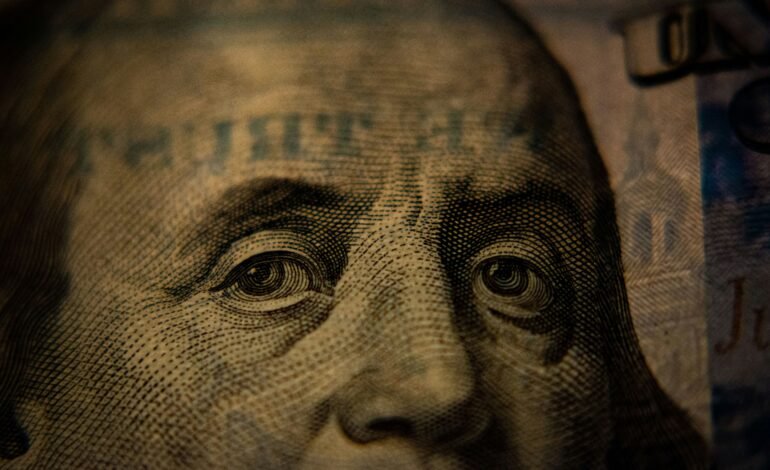Economy: US between high tariffs and a weakened dollar
Trump's tariffs weaken the dollar: the Mexican peso strengthens, the Brazilian real gains ground, and the Peruvian sol remains stable.

In the first months of 2025, the Donald Trump administration implemented an ambitious tariff strategy, including the so-called Liberation Day tariffs, with increases in most imports to the U.S. This policy has had broader economic effects, including a significant depreciation of the dollar against other major currencies.
How much has the dollar fallen?
The dollar has lost around 10-11% against a basket of foreign currencies in the first half of the year. This is its worst first-half performance since 1973.
Contrary to earlier expectations, the US dollar index (DXY) has weakened substantially, reaching multi-year lows against the euro and other currencies.
Why has the dollar fallen?
Analysts identify several factors as drivers of this decline:
- Broad tariffs and foreign retaliation
The tariffs announced in global tariffs have triggered reactions from other countries, which have threatened or implemented retaliation. When tariffs are accompanied by these responses, the dollar tends to depreciate. - Monetary policy and uncertainty about interest rates
Expectations that the Federal Reserve will cut rates, coupled with fiscal stimulus, are increasing the supply of dollars and reducing their attractiveness against other currencies. - Fiscal concerns
The growing budget deficit, coupled with massive spending packages, fuels doubts about economic sustainability. This also weakens the perception of the dollar as a safe haven. - Foreign investors protect themselves
A notable increase in hedged U.S. investments has been observed, indicating that investors want to avoid losses from currency fluctuations. This reduces direct demand for dollars.
Implications
U.S. exports could benefit from becoming more competitive due to a weaker dollar. But imported goods become more expensive for American consumers, which can increase inflation. Companies that rely on imported inputs face higher costs.
In the medium term, if confidence in the currency continues to decline, it could affect the dollar's position as a global reserve currency.
What is known about the fall of the dollar?
The dollar index (DXY) shows its worst performance in that period since 1973. The depreciation has accelerated after important announcements such as the so-called tariffs Liberation Day from the United States, which generated uncertainty about foreign economic policy.
How has it fared in Latin America?
Here are some representative cases of Latin American currencies against the dollar and how they have reacted to the weakening of the greenback:
In Latin America, the weakening of the dollar has had different effects depending on the country:
In MexicoThe peso has appreciated against the US currency, having been trading higher a year ago and now holding stronger. This resilience is explained by high interest rates, which attract foreign investment, delays in the implementation of US tariffs, and relative confidence in local economic policy.
In BrazilThe real has also shown improvements against the dollar in several recent periods, albeit with more volatile behavior. Support comes from high interest rates, expectations about economic policy, and the role of exports, while some investors are taking advantage of the opportunity for profits in a weaker dollar environment.
For its part, the Peruvian sun It remains one of the most stable currencies in the region. Its depreciation against the dollar has been very moderate, thanks to factors such as trade surpluses driven by mineral exports, the accumulation of international reserves, and a more conservative monetary policy.
What does the dollar's decline mean for Latin America?
A weaker dollar means that imports could be more expensive for some Latin American countries, especially if they rely on goods priced in dollars (fuel, technology, machinery, certain foods).
But it can also benefit exporters: local products will be more competitive in international markets.
In addition, stronger currencies improve purchasing power when people buy imported goods or services, or travel.
However, this advantage depends heavily on domestic inflation, how each central bank responds, political stability, and whether currency appreciation becomes detrimental (for example, if it strangles external competitiveness).
What Trump has said
- During his first term (2017-2021), Trump had already criticized the "overly strong dollar" on several occasions, considering it an obstacle to the competitiveness of US exports.
- Under his new administration, with massive tariffs implemented this year, analysts expect Trump to seek a weaker dollar as part of his economic strategy.
Why are you interested in a weaker dollar?
- Boost exports
With a cheaper dollar, American products become more competitive abroad. This helps local businesses and reduces the trade deficit.
2. Support local industry
Trump has tied his economic agenda to the slogan "Buy American." A weaker dollar makes imports more expensive and encourages consumers and businesses to buy American-made products.
3. Tariff supplement
Tariffs seek to protect local industry by making foreign products more expensive. A weaker dollar reinforces this effect.
The downside
- Americans who depend on imports (technology, cars, food) pay more.
- It could put pressure on inflation in the US.
- It reduces the purchasing power of the dollar for international travel and purchases.
- It could erode global confidence in the dollar as a reserve currency if the trend is too pronounced.
For more stories like this, follow More Latin.
Sources:
